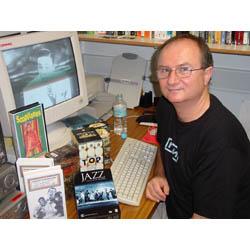Music history repeats itself with a twist
Published on 17 October, 2005
CQU researcher Jim Douglas has watched hundreds of music videos and searched world-wide for various early short films while researching links with past music technology.
Mr Douglas has examined the emergence of sound and image recording technologies in the late 1900s and has discovered similarities with early twentieth century and more contemporary forms.
“While much has been written about music videos, there has been very little recognition of links between them and these earlier forms, particularly audiovisual jukebox films of the 1940s and 60s, which were viewed by coin operated machines located in cafes and nightclubs”.
 Mr Douglas has discovered close links between these older forms of the technology and its contemporary forms; however what seems to have changed in recent years is that no longer is the performer necessarily the star of the film.
Mr Douglas has discovered close links between these older forms of the technology and its contemporary forms; however what seems to have changed in recent years is that no longer is the performer necessarily the star of the film.
“The films themselves have become the stars through ‘sheer audiovisuality’. The performer has taken a ‘backseat’ visually, in the process challenging traditionally held views about authenticity and rock music. It’s becoming more and more common to see videos where no longer do we see the performer singing and playing musical instruments in a performance setting.
“Traditionally, it could be said that musical short films were designed to promote the performer or musician as the ‘star’. Usually this was done through some visual reference of the song, either through the miming of the words, or with artists pretending to play their instruments in a performance setting such as on a stage.
“In Michael Jackson’s highly influential Thriller (1983) film clip, the star is quite plainly identified as the singer of the song and the visuals are focused on his performance of the song. However, in the film clip to Aphex Twin’s Come to Daddy (1997), no performer is identified at all in the clip. The visuals are closely synchronized with the music so that the music appears to be performing them. Other artists whose videos display sheer audiovisuality include (but is no way limited to) Radiohead, The Chemical Brothers and Tool.
“Audiences have come to identify with the total audiovisual performance, rather than any simulation of live performance which might have been present in earlier types of musical short films, creating a space for some very creative artforms to appear.
“In fact, one of the most unexpected things to emerge from my research is that I still enjoy watching for and looking at the more artistic music videos.”.
Mr Douglas is in the final stages of this 6-year project. He hopes to follow-up his research with the making of a documentary on Australian music television programs and also to conduct a smaller project that explores the independent music scene in Rockhampton and the struggle for regional acts to break the ‘big time’.

